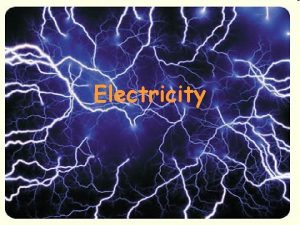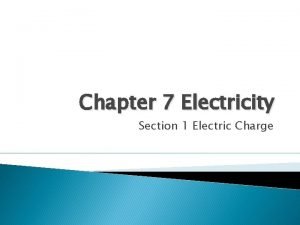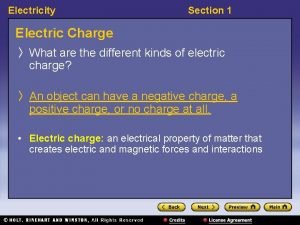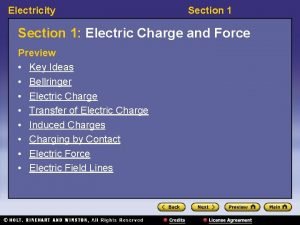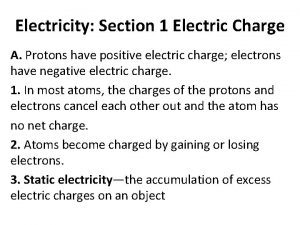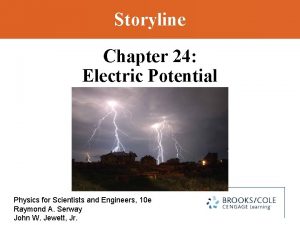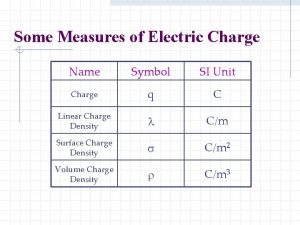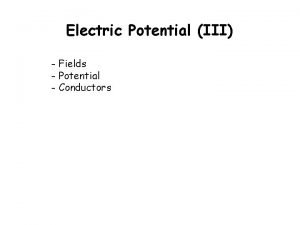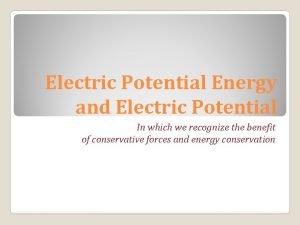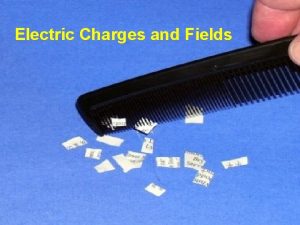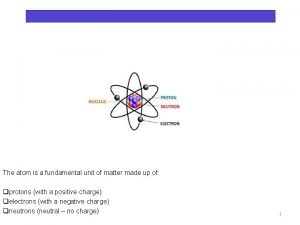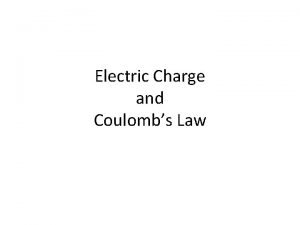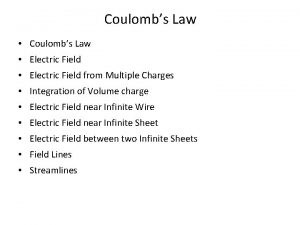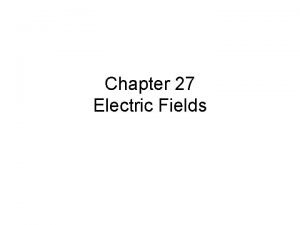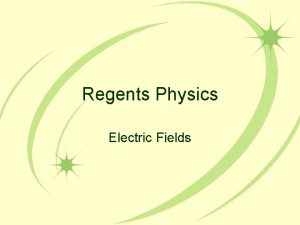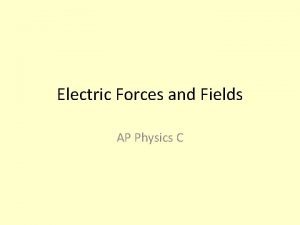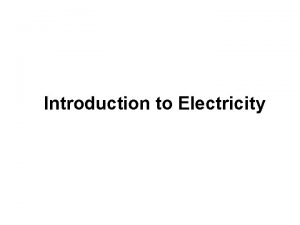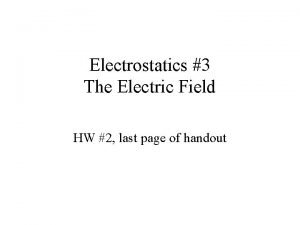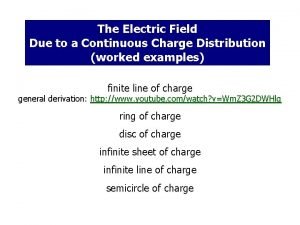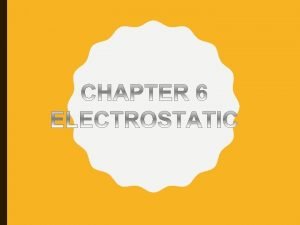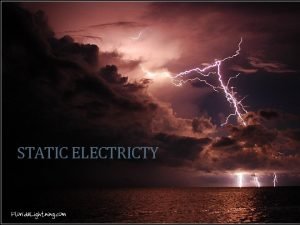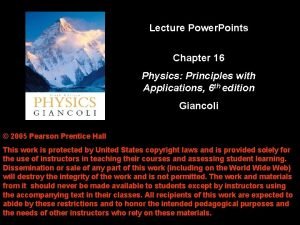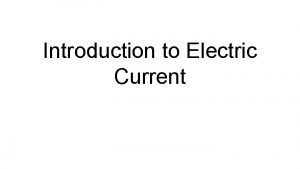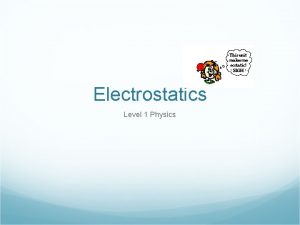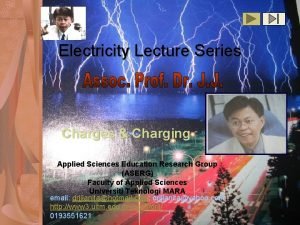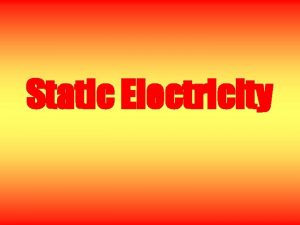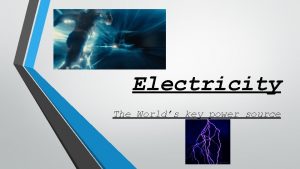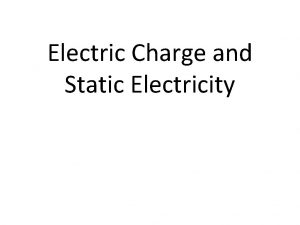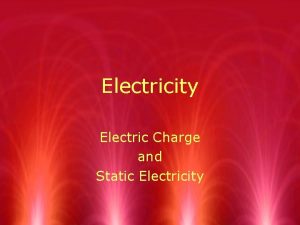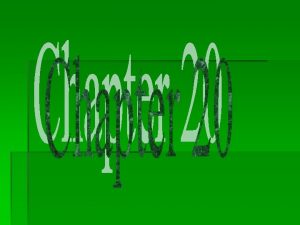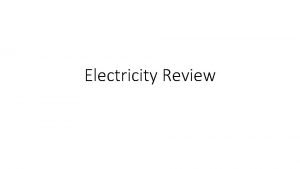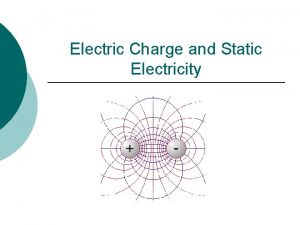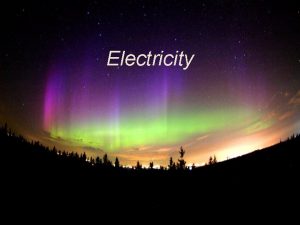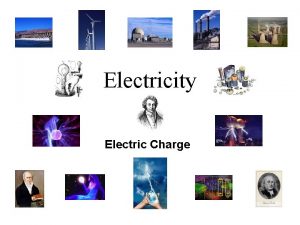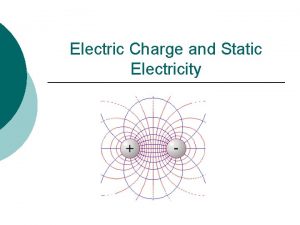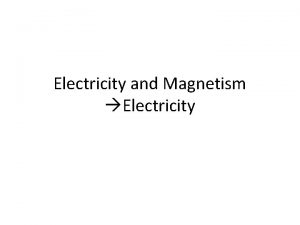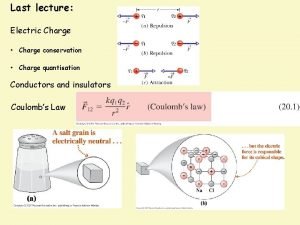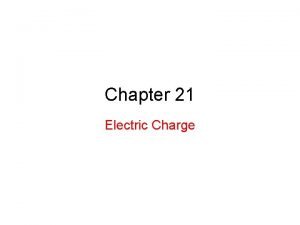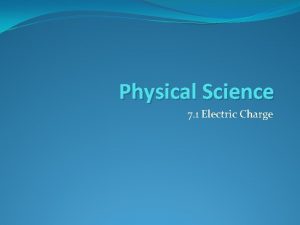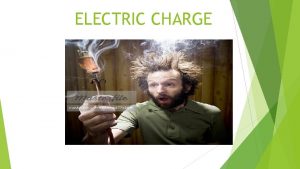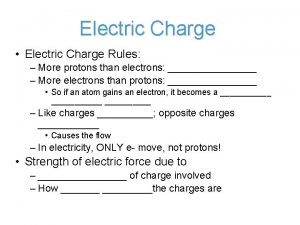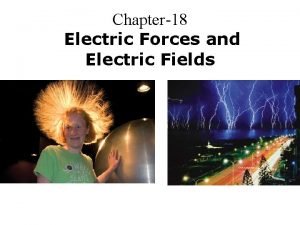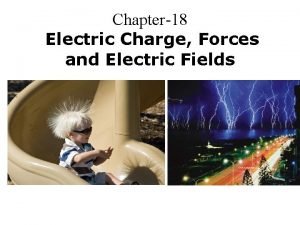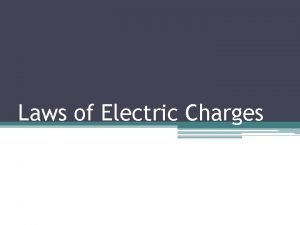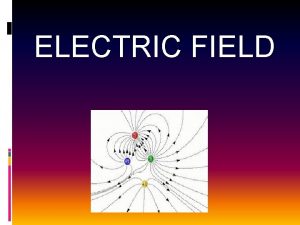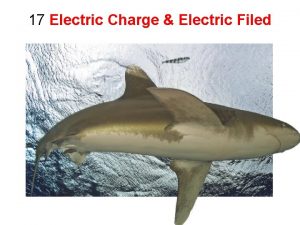Electricity Section 1 Electric Charge What is electricity
















































- Slides: 48

Electricity

Section 1: Electric Charge

What is electricity? The collection or flow of electrons in the form of an electric charge

What is static electricity? When two objects rub against each other electrons transfer and build up on an object causing it to have a different charge from its surroundings. Like the shoes rubbing against the carpet. Electrons are transferred from the carpet to the shoes.

Conservation of Charge cannot be created or destroyed. When an object becomes charged, electric charges have moved from one place to another.

Charges Exert Forces • Often when you remove clothes from the clothes dryer, they seem to stick together. • This is because some of the clothes have gained electrons by rubbing against other clothes. • The clothes losing electrons become positive. The negative clothes are attracted to the positive clothes.


Comparing Electric and Gravitational Forces The electric force between protons and electrons is 1039 times larger than the force of gravity between those particles. The electric force is so strong that if you comb your hair and transfer 1 trillionth of the electrons in a single hair to the comb, the electric force will be strong enough to overcome the force of gravity on the strand of hair.

The Van De Graaf Generator The van de Graaf generator (large silver ball) deposits electrons on the ball. When a person places their hand on the ball and the machine is turned on, electrons are transferred to and collected on the person touching the silver ball. Why do you think this machine affects the hair of the children in the picture?

What causes you to be shocked when you rub your feet across carpet? An electrical discharge is the passing of an electric current through the air from a negatively charged object to a positively charged object. This is what causes lightning!

What are Conductors & Insulators? • A conductor is a material which allows an electric current to pass. Metals are good conductors of electricity. • An insulator is a material which does not allow an electric current to pass. Plastic, glass, wood, and rubber are good insulators

Charging Objects • Charging by Contact- the process of transferring charge by touching or rubbing. • Charging by Induction- the rearrangement of electrons on a neutral object caused by a nearby charged object.

Lightning & Thunder • Lightning Video

Detecting Electric Charge • A: Uncharged • B: Negatively Charged • C: Positively Charged

Section 2: Electric Current

Current and Voltage Difference • Electric Current- the net movement of electric charges in a single direction. – Measured in amperes. • 1 ampere = 1 million billion electrons flowing past a point each second!!!

Voltage Difference • Electric charge flows from higher voltage to lower voltage. – A voltage difference is related to the force that causes electric charges to flow. • Measured in volts.


Electric Circuits • Circuit- a closed path that electric current flows. – If the path opens, the current will not flow.

What are batteries? Batteries are composed of a chemical substance which can generate voltage which can be used in a circuit. There are two kinds of batteries: dry cell and wet cell batteries. Below is an example of a dry cell. The zinc container of the dry cell contains a moist chemical paste surrounding a carbon rod suspended in the middle.

Wet cell batteries are most commonly associated with automobile batteries. A wet cell contains two connected plates made of different metals or metal compounds in a conducting solution. Most car batteries have a series of six cells, each containing lead and lead oxide in a sulfuric acid solution.

What is electrical resistance? Resistance (R) is the opposition to the flow of an electric current, causing the electrical energy to be converted to thermal energy or light. The metal which makes up a light bulb filament or stovetop eye has a high electrical resistance. This causes light and heat to be given off.

Temperature, Length, and Thickness Resistance increases if: • Temperature Increases • Wire becomes longer • Wire becomes thinner

Light Bulbs • In a 60 Watt bulb, the filament is a piece of tungsten wire coiled to be only a few cm long. The uncoiled wire is 2 m long, and only 0. 25 mm thick, so the resistance is large enough to cause the bulb to glow!

What are electric circuits? • Circuits typically contain a voltage source, a wire conductor, and one or more devices which use the electrical energy.

Ohm’s Law • According to Ohm’s Law, the current in a circuit equals the voltage difference divided by the resistance. • Stuff you need to know: Symbol Unit Current I A (amperes) Voltage Difference V V (Volts) Resistance R Ω (Ohms) Formula I= V/R

Ohm’s Law Practice #1 • A toy car with a resistance of 2Ω is connected to a 3 V battery. How much current flows through the car? ? ? – Step 1: WRITE WHAT YOU KNOW: • I= • V= • R= – Choose the equation you will use: • I=V/R – Solve!

Ohm’s Law Practice #2 • Calculate the voltage difference in a circuit with a resistance of 25Ω if the current in the circuit is 0. 5 A. – Step 1: WRITE WHAT YOU KNOW: • I= • V= • R= – Choose the equation you will use: • V= I * R – Solve!

Ohm’s Law Practice #3 • A current of 0. 5 A flows in a lightbulb when the voltage difference between the ends of the filament is 120 V. What is the resistance of the filament? – Step 1: WRITE WHAT YOU KNOW: • I= • V= • R= – Choose the equation you will use: • R= V/I – Solve!

Section 3: Electrical Energy

Circuits • Circuits include 3 parts: – 1. Source of voltage difference (battery, power outlet). – 2. A device that uses the electrical energy. – 3. Conductors (wires) that connect the devices to the source of voltage difference – Forms a CLOSED PATH!

Series Circuits • In a series circuit, the current only has one loop to flow through. – Examples: flashlights and some holiday lights. – Problems? ? ?

Parallel Circuits • A parallel circuit has multiple pathways for the current to flow. If the circuit is broken the current may pass through other pathways and other devices will continue to work.

What is the difference between an open circuit and a closed circuit? • A closed circuit is one in which the pathway of the electrical current is complete and unbroken. • An open circuit is one in which the pathway of the electrical current is broken. A switch is a device in the circuit in which the circuit can be closed (turned on) or open (turned off).

Fuses & Circuit Breakers • Most household wiring is logically designed with a combination of parallel circuits. Electrical energy enters the home usually at a breaker box or fuse box and distributes the electricity through multiple circuits.

Electric Power • Electric Power- the rate at which electrical energy is converted into another form of energy. – Example: • Hairdryer ~1875 W • Computer ~ 450 W

Calculating Electric Power • Power (W) = Current (A) x Voltage Difference (V) • P=IV • The unit of electric power is the watt (W). Because that is a very small unit electric power is expressed in kilowatts (k. W). – 1 kilowatt = 1000 watts.

Electric Power Practice Problem #1 How much power is used in a circuit which is 110 volts and has a current of 1. 36 amps? – Step 1: WRITE WHAT YOU KNOW: • I= • V= • P= – Choose the equation you will use: • P=IV – Solve!

Electric Power Practice Problem #2 • The current in a clothes dryer is 15 A when it is plugged into a 240 -volt outlet. How much electric power does the clothes dryer use? – Step 1: WRITE WHAT YOU KNOW: • I= • V= • P= – Choose the equation you will use: • P=IV – Solve!

Electric Power Practice Problem #3 • A toaster oven is plugged into an outlet where the voltage difference is 120 V. How much power does the toaster oven use if the current in the oven is 10 A? – Step 1: WRITE WHAT YOU KNOW: • I= • V= • P= – Choose the equation you will use: • P=IV – Solve!

Electric Power Practice Problem #4 • A VCR that is NOT playing still uses 10. 0 W of power. What is the current in the VCR if it is plugged into a 120 V outlet? – Step 1: WRITE WHAT YOU KNOW: • I= • V= • P= – Choose the equation you will use: • P=IV – Solve!

Electrical Energy • Using electric power costs money! • Electric companies charge by the amount of electrical energy used, instead of the electric power used. • Electric Energy is measured in units of kilowatt hours (k. Wh) and can be calculated from this equation: • Electrical Energy (k. Wh) = Power (k. W) * Time (h) • E= Pt

Electric Energy Practice Problem #1 • A microwave oven with a power rating of 1, 200 W is used for 0. 25 h. How much electrical energy is used by the microwave? – Step 1: WRITE WHAT YOU KNOW: • P= • t= • E= – Choose the equation you will use: • E=Pt – Solve!

Electric Energy Practice Problem #2 • A refrigerator operates on average for 10. 0 h per day. If the power rating on the refrigerator is 700 W, how much electrical energy does the refrigerator use in one day? – Step 1: WRITE WHAT YOU KNOW: • P= • t= • E= – Choose the equation you will use: • E=Pt – Solve!

Electric Energy Practice Problem #3 • The current flowing through an appliance connected to a 120 -V source is 2 A. How many kilowatt hours of electrical energy does the appliance use in 4 hours? – Step 1: WRITE WHAT YOU KNOW: • P= • t= • E= • I= • V= – Choose the equation you will use: • E=Pt AND: P=IV – Solve!

The Cost of Using Electrical Energy • How do we find out how much we spend on each appliance we use? ? ? – Electrical energy x $ per kilowatt hour • Example: If a 100 W lightbulb is left on for 5 h, the amount of electrical energy is: – E=Pt – E= (0. 1 k. W) (5 h) = 0. 5 k. Wh – If the power company charges $. 10 per k. Wh, the cost of using the bulb for 5 hours is: – Cost= (k. Wh used)(cost per k. Wh) – Cost= (0. 5 k. Wh) ($0. 10/k. Wh) = $0. 05

The Cost of Using Electrical Energy~ Practice • Use the following information to determine the cost to run the following appliances. Assume the cost per k. Wh is $0. 09/k. Wh. Appliance Power Rating Hours Used Daily Hair Dryer 1000 W 0. 25 h Stereo 100 W 2. 0 h Color TV 200 W 4. 0 h Clothes Dryer 1500 W 2. 0 h Daily Cost Monthly Cost (Assume 30 Days/Month)

Don’t be discouraged! You can do this!!!
 Chapter 6 section 1 electric charge worksheet answers
Chapter 6 section 1 electric charge worksheet answers Electricity section 1 electric charge
Electricity section 1 electric charge Electricity section 1 electric charge
Electricity section 1 electric charge Difference between charge and electric charge
Difference between charge and electric charge Electrons flowing
Electrons flowing Chapter 21 electric charge and electric field
Chapter 21 electric charge and electric field Chapter 21 electric charge and electric field
Chapter 21 electric charge and electric field K constant unit
K constant unit Units of a charge
Units of a charge Section 1 electric charge crossword puzzle answers
Section 1 electric charge crossword puzzle answers Chapter 17 section 1 electric charge and force answer key
Chapter 17 section 1 electric charge and force answer key Section 1 electric charge
Section 1 electric charge Example of charge by contact
Example of charge by contact Static electricity and current electricity
Static electricity and current electricity Static electricity and current electricity
Static electricity and current electricity How are static electricity and current electricity alike
How are static electricity and current electricity alike Electric field of a finite line charge
Electric field of a finite line charge Symbol of electric field strength
Symbol of electric field strength What is electric charge measured in
What is electric charge measured in Electrostatics formula
Electrostatics formula Electric field of a finite line charge
Electric field of a finite line charge Electrical potential energy
Electrical potential energy Amber effect
Amber effect Units of electric charge
Units of electric charge Columbs law
Columbs law Sheet of charge electric field
Sheet of charge electric field Electric field equations
Electric field equations Properties of coulomb's law
Properties of coulomb's law Electric field lines about a point charge extend
Electric field lines about a point charge extend Electric field of line charge
Electric field of line charge Charge q unit
Charge q unit Force on charge in electric field
Force on charge in electric field Electric field of continuous charge distribution
Electric field of continuous charge distribution Unit of electrical force
Unit of electrical force Static electricty
Static electricty Units of charge
Units of charge Continuous flow of electric charges
Continuous flow of electric charges Induction charging physics
Induction charging physics Electric charge
Electric charge Two 40 gram masses each with a charge
Two 40 gram masses each with a charge Electric charge
Electric charge Stationary electric charge
Stationary electric charge Unidirectional flow of electric charge
Unidirectional flow of electric charge Energy electric field
Energy electric field Potential due to charged sphere
Potential due to charged sphere Electric potential vs electric potential energy
Electric potential vs electric potential energy Electric potential and electric field
Electric potential and electric field A suitable electric pump in an electric circuit is a
A suitable electric pump in an electric circuit is a Electric charges and electric forces lesson outline
Electric charges and electric forces lesson outline

